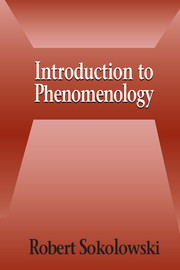Book contents
- Frontmatter
- Contents
- Acknowledgments
- Introduction
- 1 What Is Intentionality, and Why Is It Important?
- 2 Perception of a Cube as a Paradigm of Conscious Experience
- 3 Three Formal Structures in Phenomenology
- 4 An Initial Statement of What Phenomenology Is
- 5 Perception, Memory, and Imagination
- 6 Words, Pictures, and Symbols
- 7 Categorial Intentions and Objects
- 8 Phenomenology of the Self
- 9 Temporality
- 10 The Life World and Intersubjectivity
- 11 Reason, Truth, and Evidence
- 12 Eidetic Intuition
- 13 Phenomenology Defined
- 14 Phenomenology in the Present Historical Context
- Appendix: Phenomenology in the Last One Hundred Years
- Select Bibliography
- Index
10 - The Life World and Intersubjectivity
Published online by Cambridge University Press: 05 June 2012
- Frontmatter
- Contents
- Acknowledgments
- Introduction
- 1 What Is Intentionality, and Why Is It Important?
- 2 Perception of a Cube as a Paradigm of Conscious Experience
- 3 Three Formal Structures in Phenomenology
- 4 An Initial Statement of What Phenomenology Is
- 5 Perception, Memory, and Imagination
- 6 Words, Pictures, and Symbols
- 7 Categorial Intentions and Objects
- 8 Phenomenology of the Self
- 9 Temporality
- 10 The Life World and Intersubjectivity
- 11 Reason, Truth, and Evidence
- 12 Eidetic Intuition
- 13 Phenomenology Defined
- 14 Phenomenology in the Present Historical Context
- Appendix: Phenomenology in the Last One Hundred Years
- Select Bibliography
- Index
Summary
After the extremely formal issues discussed in Chapter 9, we now move on to more concrete topics. In this chapter we will consider the Lebenswelt, the life world, the world in which we live, and we will also consider intersubjectivity, the kind of intentionality that functions in our experience of other persons. The familiar character of the lived world and the public character of intersubjectivity will bring a welcome relief from the austere analyses of the preceding chapter.
THE LIFE WORLD AS A PROBLEM
The life world arises as a philosophical issue in contrast with modern science. The highly mathematical form of science that was introduced by Galileo, Descartes, and Newton led people to think that the world in which we live, the world of colors, sounds, trees, rivers, and rocks, the world of what came to be called “secondary qualities,” was not the real world; instead, the world described by the exact sciences was said to be the true one, and it was quite different from the world we directly experience. What looks like a table is really a conglomeration of atoms, fields of force, and empty spaces. Atoms and molecules, and the forces, fields, and laws described by science, are said to be the true reality of things. The world we live in and directly perceive is only a construct made by our minds responding to the input from our senses, and the senses react biologically to physical stimuli that are transmitted from objects.
- Type
- Chapter
- Information
- Introduction to Phenomenology , pp. 146 - 155Publisher: Cambridge University PressPrint publication year: 1999



